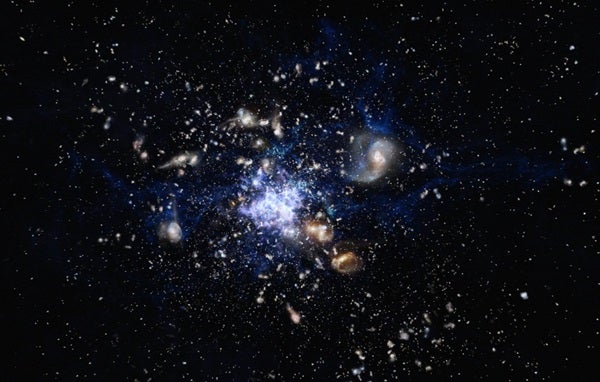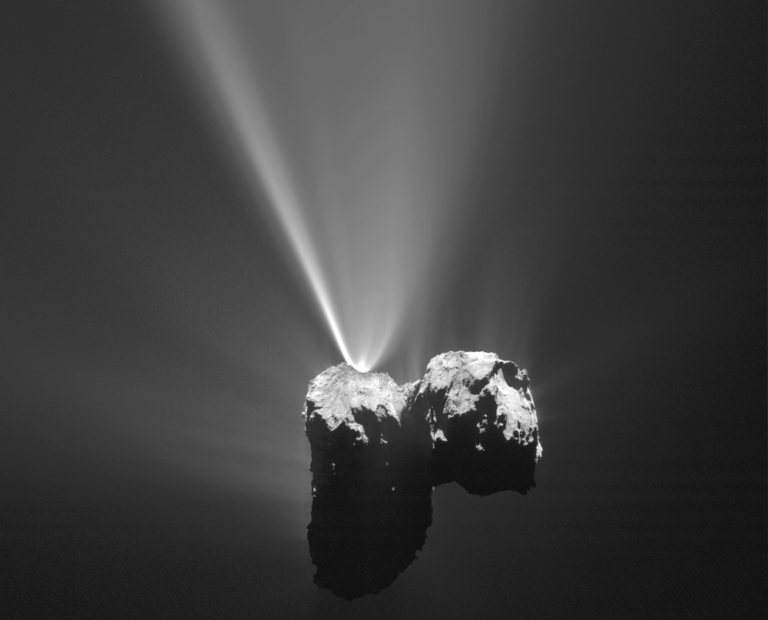Before they turn to cannibalism, massive galaxies spend their infancy gobbling up recycled gas from earlier generations of star formation.
The Spiderweb Galaxy is actually more of a galaxy-in-progress. One day, it will be an enormous elliptical galaxy at the heart of a galactic cluster, but at the moment – technically, at a moment ten billion years away whose light is only just reaching us on Earth – it’s a group of about a dozen small proto-galaxies, slowly falling together and merging amid a vast halo of cold gas. At the center of that spiderweb of gas and merging galaxies sits a larger radio galaxy, which will one day form the core of the giant elliptical galaxy.
At 10 billion light-years away, the Spiderweb Galaxy offers astronomers a window into the formative years of the largest galaxies in the universe. It turns out that the birth of a super-galaxy is a more complex process than previously thought.
How Galaxies Grow Up to Be Cannibals
Until now, it had been widely accepted that as a massive galaxy forms, it draws in material from nearby smaller galaxies, cannibalizing them to feed its own growth. That’s because we’ve mostly been observing less distant, more mature super-galaxies. The Spiderweb Galaxy offers a look at much earlier stages of a super-galaxy’s lifespan.
“For the past 10 billion years, these giant galaxies have grown mostly by cannibalizing smaller galaxies,” wrote astronomer Bjorn Emonts of the Center for Astrobiology in Madrid, Spain, and his colleagues in a paper published in Science.
Before they grew up to become cannibals, however, the largest galaxies in the universe may have actually been recyclers. A few billion years before the cannibal phase, computer models predict, these enormous galaxies probably condensed directly from clouds of gas expelled by dying stars in other nearby galaxies. When the galaxy runs out of material, it begins stripping gas and stars from nearby smaller galaxies.
“By that time the galaxy is so big that, as a result of its large gravitational pull, it will continue to grow by cannibalizing smaller galaxies,” said Emonts.
New radio astronomy observations of the Spiderweb Galaxy back up what the models suggested: monster galaxies condense from clouds of intergalactic gas, and they don’t turn to cannibalism until they’ve run out of other material.
Looking into the Spiderweb
Based on observations with the Australia Compact Array (ATCA) and the Karl G. Jansky Very Large Array (VLA), a cloud of carbon monoxide about 70 kiloparsecs, or 228,000 light-years, wide surrounds the radio galaxy at the heart of the Spiderweb. Carbon monoxide shows up much more brightly in radio wavelengths than the hydrogen that actually provides most of the fuel for star formation, so it makes a handy tracer.
Carbon monoxide also provides a vital clue about the origin of the molecular cloud that’s condensing into a new galaxy. Carbon and oxygen form only in the bowels of massive stars, so the gas in the Spiderweb must have been formed in early stars and then expelled in supernovae. The Spiderweb Galaxy is presently dining on recycled material, probably from an earlier generation of star formation in those protocluster galaxies.
“By looking far away in space, we see galaxies as they were when the Universe was still very young. Like with children, these protogalaxies are smaller and often more active, in terms of star formation, than ‘adult’ galaxies around us,” said Emonts.
If the central galaxy were cannibalizing its smaller neighbors in order to grow, Emonts and his colleagues reasoned, then most of the gas in the Spiderweb would probably be in the smaller proto-galaxies. So, with the VLA, they took a higher-resolution look at how much carbon monoxide showed up in the individual proto-galaxies.
It turned out that about a third of the gas was concentrated in the large central galaxy, but the other two-thirds didn’t seem to be concentrated in any of the proto-galaxies. Instead, it was mostly found in the space between the galaxies, which astronomers call the intergalactic medium. The Spiderweb Galaxy is condensing directly from that gaseous medium between galaxies.
These observations provide some evidence that in the very early universe, giant galaxies in clusters like this one formed out of large regions of gas recycled from earlier generations of stars that had already lived and died.
“So on the one hand, this enormous gas cloud is forming stars, but on the other hand it consists of material from previous stars — a form of cosmic recycling,” said Emonts.
This phase of the Spiderweb Galaxy’s lifespan is likely to last about another billion years. “There is so much gas in this cloud that it will take at least a billion more years for all the gas to have turned into stars,” said Emonts. “At that time, the galaxy will be almost a quarter of a million light-years in diameter, already more than twice the size of our Milky Way galaxy, and it will continue to grow.”
A Web of Unanswered Questions
What’s less clear is how that material got expelled out of the individual galaxies and into the vast intergalactic medium, but Emonts and his team have some ideas.
“It is likely that the energy released by all the living stars in the individual galaxies pushes the material from dead stars out into the surrounding gas cloud, but more observations are needed to confirm this,” he said. “Also keep in mind that stars are being formed within the gas cloud itself, so when they explode, that material immediately enters the gas cloud.”
The gas cloud is a very active area of star formation. The region of carbon monoxide gas roughly overlaps with an area of star formation previously detected by Hubble ultraviolet observations. Given all that star formation and the action of the merging galaxies, astronomers still aren’t quite sure how the gas cooled down enough to form molecules instead of free-floating atoms. “With all the protocluster galaxies flying through the gas cloud and merging with each other, we would have expected that all the gas would be heated to high temperatures,” said Emonts.
The most likely possibility is that the forming galaxy may actually be cooling its own meal. “We have indications that perhaps the supermassive black hole at the center helps to speed up this process of gas cooling, by blasting jets of relativistic particles far out into the gas cloud,” he said. “The definite answer may be provided by large new telescopes that can study molecular gas across a wide range of temperatures, such as the James Webb Space Telescope and the Atacama Large Millimeter Array in Chili,” said Emonts.
Most of the galaxies in the surrounding cluster are comparatively small, but other large ones, like the radio galaxy at the heart of the Spiderweb, are scattered throughout the cluster. “Detailed telescope observations of these other large galaxies may reveal whether or not the Spiderweb Galaxy is unique, or merely one of many galaxies that are formed this way,” said Emonts.










